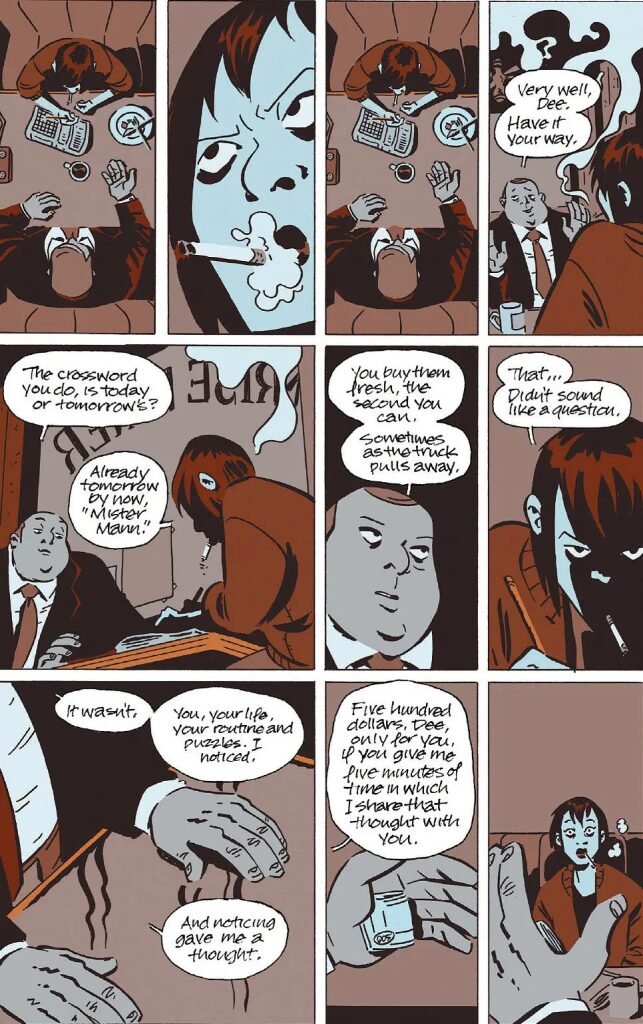Writer, Matt Fraction
Artist Elsa Charretier
Image Comics, November 9, 2019
Something sinister lurks beneath the waters of this 2019 collected volume of the title November. It is written by Matt Fraction, a well-known and award-winning comic book writer, and with art by Elsa Charretier, who is well known for her body of work for large American comic book publishers.
The protagonists are uniformly akin to washed up debris. They reside in a nameless city. The environment is greasy and corrupt. Ms Charretier’s art, very reminiscent of that of David Mazzucchelli in the equally dark Batman: Year One (DC Comics, 1987), wonderfully conveys this grit. We have cliches in abundance here – a depiction of sluggish and parasitic individuals, and looming thugs in uniforms with military moustaches. It is clear from their appearance alone that the cops are the bad guys in November.
And each subplot has a different colour palate: the first is brown and pale blue, the second is teal and grey, then yellow and mustard, then solidly grey, and finally returning to brown and blue. The colours are sickly and surreal: there are no skin tones. It is as if the hues of the city have etched themselves into the skin of the characters. This is the mastery of veteran colourist Matt Hollingsworth, whose skills we first bewitched by on Marvel Comics’ Hawkeye which he worked on with Mr Fraction in 2012.

A woman called Dee is the main player in the initial and final “brown and pale blue” subplot. Dee is thoroughly washed up. She has a compulsion to complete puzzles and crosswords. Apparently as a consequence of this, Dee is recruited by a mysterious man – “Mr Mann”- who knows far too much about her. This anonymous player barely masks his intimidating presence beneath casual chatter and a cigarette. He wishes Dee to participate in a strange routine: the morning delivery of a code by old fashioned radio broadcast, in exchange for which she will be paid significant sums of money.
The code appears in a newspaper, she uses a key to de-cypher it, and she broadcasts the de-cyphered words. The very first time we see Dee broadcasting the code, it is an enigma. “Tango, Seven, Dutch, Eleven, Widow, Nine, Foxtrot”. It means nothing to us, and nothing to Dee, but it means a lot to someone, somewhere else. “Why, what do you do for a living?” Dee churlishly asks the reader, after she burns the code and exits the rooftop pigeon enclosure hiding the radio equipment. Dee can’t dispose of the cash fast enough. The burden of it leads her to heavy drinking and consorting with strippers. She is lonely and just wants to talk: the strippers are only interested in the hustle.

One morning, the source of Dee’s code, the newspaper, has nothing. She completely freaks out. She had been warned by her employer as to what might happen in that circumstance. “Well, Dee. Hm. Supposin’ someday that does happen? That would mean it’s the end of the goddamn world”. The prospect of no code to broadcast is terrifying. Having no idea what else to do, sweating a river, Dee broadcast the words. “Zero zero zero.”
It triggers chaos. There is mass casualty event later in the city, as bombs explode, and police officers rush to respond.
The second teal and grey subplot concerns a gun in a puddle. It is short and brutal vignette, concerned with a well-meaning bystander to the action who finds an abandoned revolver in the street. Sticking her neck out and doing the right thing leads to her abduction by police officers.

It is in that context that we meet the next player in the drama, an emergency line operator named Kowalski. Unlike other cops in the city, Kowalski cares. She struggles with an alcohol problem, as well as being unwillingly relegated to the job of answering emergency calls. This is not what she expected to be when she first became a police officer. She has run-in with a nameless cop, a burly man with a moustache. This policeman is completely corrupt. He is the owner of the gun in the puddle.
The final solidly grey piece of the puzzle is another rookie policeman, who joins evidence management. The veterans are not especially pleasant to the newcomer, and treat him, in their words, like an insect. The botched handling of evidence results in a violent criminal being released. This is met with retribution by the police: they squeeze in next to the crook at a urinal, and we then in the jarringly immediate next panel, from a very high angle, witness the shanghaied man being shot in the head and dropped from a bridge into a dark rover.
Police corruption and lethal over-reach is currently very topical in the United States. Setting aside the bleak social commentary on the almost complete overlap between organised crime and policing in America, November is a comic book written by someone who has become a master of his craft. Who knows where this is going? The scattered jigsaw pieces, the mystery that only Dee herself is likely to solve, is completely intriguing. The second volume has been recently released, and we will be reviewing that in a few weeks to see what else we can pull together from this complex noir drama.


